Diversity in Living Organisms Class 9 Notes Science
1. Multitude of life forms surrounds us. These diverse life forms have evolved on the planet earth over million of years.
2. The diverse life forms are abundant in warm and humid tropical regions of the earth, between the tropic of Cancer and the tropic of Capricorn. This is called the region of mega diversity.
3. The method of placing organisms into groups and subgroups depending on the extent of similarities and differences is called classification. While classifying organisms relationship between different organisms is also exhibited.
4. Taxonomy is the branch of biology which deals with identification, naming and classification of organisms.
5. Nomenclature is the system of naming plants and animals.
6. Classification makes our study of living organisms easier. It saves time and avoids confusion. We can have a broad idea regarding all organisms by studying one or two representatives of a group.
7. The seven obligate categories in hierarchical classification are kingdom, division/ phylum, class, order, family, genus and species. Species is the basic unit of classification whereas kingdom is the highest taxonomic category.
8. Greek thinker Aristotle classified animals according to their habitat (place they live) i.e., land, air and water.
9. Carolus Linnaeus is known as the father of taxonomy. He gave binomial system of nomenclature as well as two-kingdom classification. In 1758 he suggested that the diverse life forms can be classified either into plant or animal kingdom.
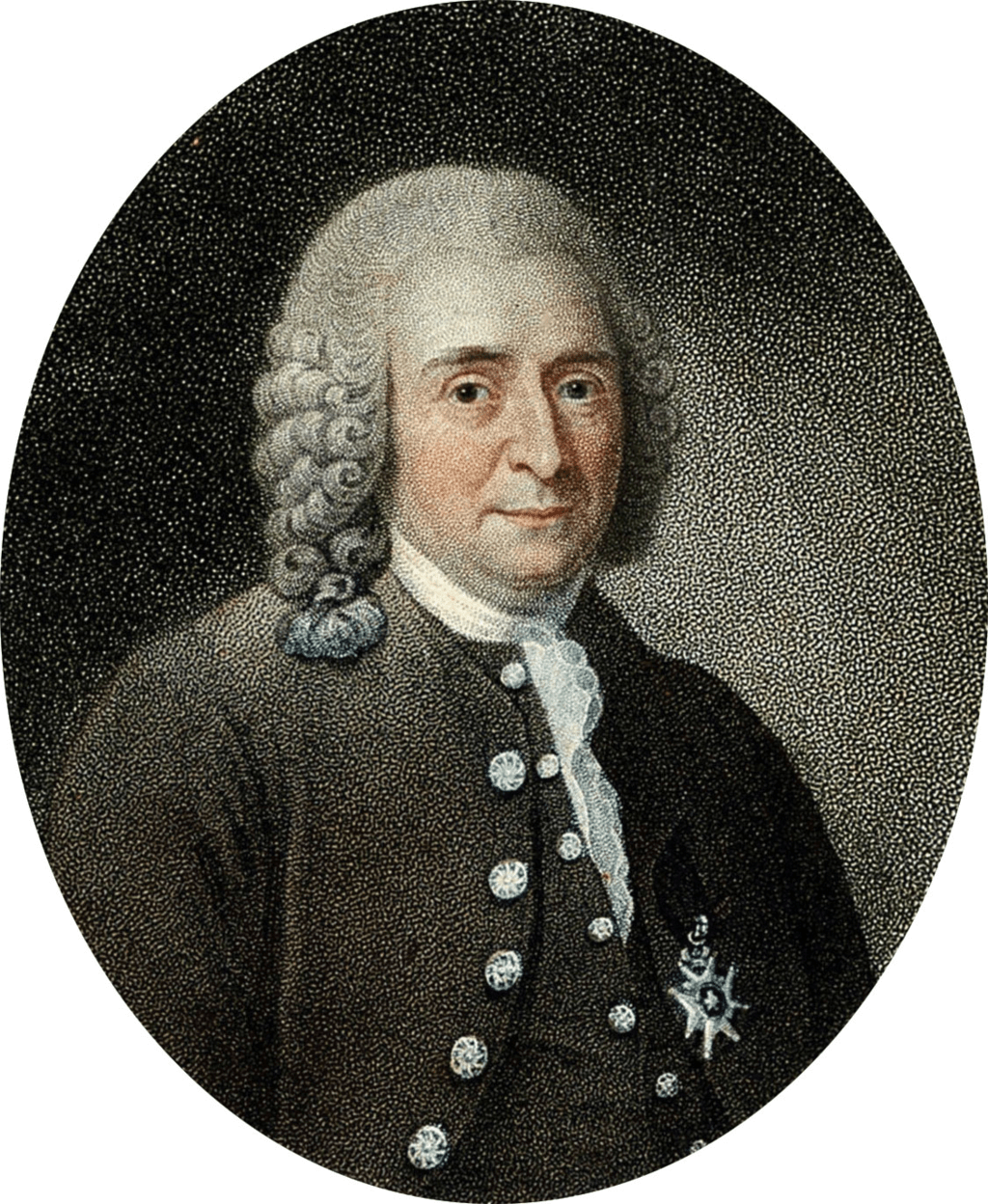 Carolus Linnaeus
Carolus Linnaeus
10. Common names differ from country to country but scientific names are the same all over the world. According to the binomial system of nomenclature, there are two parts in a scientific name. The first part is the generic name whereas the second part is the specific name. Both these names would be used in latin forms. The name of the genus begins with the capital letter and the specific name begins with the small letter. When printed the scientific name is given in italics. On the other hand when written by hand, the genus name and the species name have to be underlined separately.
11. E.H. Haeckel in 1894 raised a third kingdom Protista for unicellular organisms.
12. Robert Whittaker (1969) gave five kingdoms system of classification by adding kingdoms - Monera and Fungi to existing three kingdoms.
13. The major criteria considered for classifying all organisms into five major kingdoms are as follows:
- Complexity of cell structure (Eukaryotes or Prokaryotes)
- Complexity of organism’s body (Unicellular or Multicellular)
- Mode of nutrition (Autotrophic or Heterotrophic)
- Reproduction
- Ecological role and Phylogenetic relationships (Producers, Consumers or Decomposers)
14. Carl Woese (1977) subdivided Kingdom Monera into Archaebacteria and Eubacteria.
15. Classification of life forms is closely related to their evolution. Most life forms that we see today have arisen by the accumulation of changes in a body design that allows the organism possessing them to survive better.
16. Charles Darwin first described the idea of evolution in 1859 in his book, ‘The Origin of Species’.
17. Since there is a possibility that complexity in design will increase over evolutionary time, it may not be wrong to say that primitive organisms are simpler while advanced organisms are more complex.
18. Whittaker classified the living organisms into the following five kingdoms:
(i) Monera
(ii) Protista
(iii) Fungi
(iv) Plantae
(v) Animalia
19. Monera:
(i) A kingdom of prokaryotes which basically includes unicellular members. In filaments and colonies the cells are similar and independent.
(ii) Monerans do not have a well-defined nucleus and membrane-bound cell organelles. The genetic material lies directly inside the cytoplasm and is called as nucleoid.
(iii) Cell wall is made of murein or peptidoglycan as in bacteria, cyanobacteria. It is absent in some monerans such as Mycoplasma.
(iv) Mode of nutrition can be either autotrophic as in blue-green algae or heterotrophic as in bacteria. All nitrogen fixing bacteria belong to kingdom monera e.g., Rhizobium in root nodules of legumes.
(v) Examples: Bacteria, Blue-green Algae and Mycoplasma.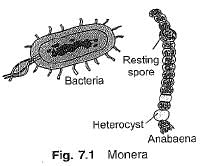
20. Protista:
(i) It includes unicellular eukaryotic organisms.
(ii) Presence of true nucleus and membrane-bound cell organelles.
(iii) Locomotion is generally present. It occurs with the help of flagella (Euglena), cilia (Paramecium) and pseudopodia (Amoeba).
(iv) Some protists are covered with cell wall (most photosynthetic protists) while others do not possess (protozoan protists).
(v) Their mode of nutrition can be autotrophic (unicellular algae-like diatoms and dinoflagellates as well as Euglena like organisms) or heterotrophic (as in protozoans). Holozoic mode of nutrition is seen in Amoeba where solid food particles are ingested.
(vi) Examples: Amoeba. Euglena and Paramecium.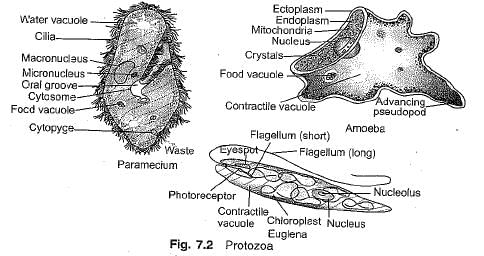
21. Fungi:
(i) A kingdom of achlorophyllous, heterotrophic, spore-producing, cell wall containing eukaryotes.
(ii) Body of fungi is composed of a network of thin thread-like structures called mycelium. Each fine thread-like structure is called as hyphae.
(iii) Fungi are basically multicellular except for the yeast. Some lower forms are multinucleate.
(iv) Cell-wall of fungal members is made up of either cellulose or chitin.
(v) Fungi are heterotrophic. Most of them are decomposers. Heterotrophic mode of nutrition may be either parasitic or saprophytic.
(vi) Reserve food material is glycogen and oil.
(vii) Some fungal species live in permanent mutually dependent symbiotic relationship with blue-green algae or cyanobacteria Such symbiotic life forms are called lichen; where the fungal component provide, protection to the algae as well as helps in fixation and absorption of water and minerals. On the other hand the alga component manufactures food not only for itself but for the fungal component also.
(viii) Examples: Yeast, Mushroom, Aspergillus, Penicillium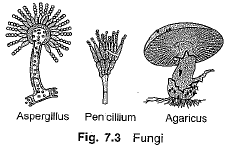
22. Kingdom Plantae:
(i) They are multicellular, chlorophyll-containing autotrophic eukaryotes with cellulosic cell walls.
(ii) Mostly autotrophs except few parasitic forms like Dodder (Cuscuta) and saprophytic forms like Monotropa.
(iii) Kingdom plantae show lots of diversity, so has been divided into groups and subgroups which are discussed as follows:
(a) Thallophyta
(i) A division of plantae whose members do not have a well-differentiated body.
(ii) The plants of this group are commonly called algae.
(iii) Plants are predominantly aquatic. Only few occur in terrestrial habitat.
(iv) They are capable of manufacturing their own food by the process of photosynthesis,
(v) Examples: Spirogyra, Ulothrix, Ulva, Cladophora and Chara.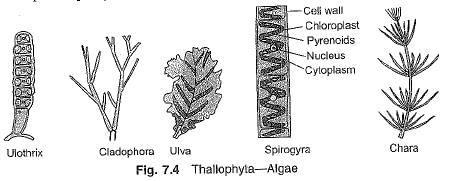
(b) Bryophyta
(i) A division of non-vascular plants which are also referred to as the “amphibians of plant kingdom” because they live in moist areas and water is essential for completion of their lifecycle.
(ii) Presence of a thalloid plant body which is differentiated into stem-like and root-like structures called rhizoids.
(iii) The plant body is a gametophyte. The sporophytic phase is dependent on it.
(iv) No specialised tissue like xylem and phloem are found in bryophytes, hence they are also called non-vascular plants.
(v) Sex organs are multicellular and jacketed. Male sex organs are called as antheridia while female sex organs are referred to as archegonia.
(vi) Examples: Riccia, Marchantia and Funaria.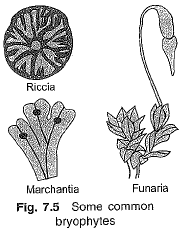 (c) Pteridophyta
(c) Pteridophyta
(i) A division of seedless vascular plants which are commonly called as cryptogams. Pteridophytes represent the highest group of cryptogams.
(ii) The plant body is a sporophyte which is differentiated into roots, stem and leaves.
(iii) Specialised vascular tissues like xylem and phloem are present for the conduction of water and other substances.
(iv) Gametophytic phase is small but independent stage in its lifecycle.
(v) Sex organs are multicellular and jacketed like those of bryophytes. Male sex organs are called as antheridia while female sex organs are referred as archegonia.
(vi) Seeds are absent.
(vii) Examples: Marsilea and Ferns.
Note: In Thallophytes, Bryophytes and Pteridophytes the reproductive organs are very inconspicuous, hence they are called cryptogamae (those with hidden reproductive organs).
(d) Gymnosperms (Naked seeded plants)
(i) A subdivision of seed plants in which the seeds are naked i.e., they are not enclosed by fruit and the sporophylls are aggregated to form cones.
(ii) Plants are usually perennial (live for many years), evergreen and woody.
(iii) Presence of male and female cones. Pollination is by wind. External water is not required for transport of male gametes. Double fertilisation is absent.
(iv) Examples: Pinus and Cycas.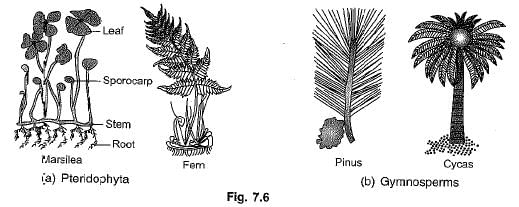 (e) Angiosperms
(e) Angiosperms
(i) A subdivision of seed plants in which seeds are enclosed by fruit and sporophylls are aggregated to form flowers.
(ii) They are also referred to as flowering plants. Plants are deciduous or evergreen, annual or perennial herbs, shrubs or trees.
(iii) Reproductive structures are flowers. Pollination occurs by wind, water and animals. Double fertilisation is present.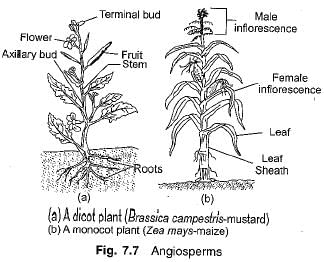 (iv) They are further sub divided into two classes on the basis of number of cotyledons in the seeds.
(iv) They are further sub divided into two classes on the basis of number of cotyledons in the seeds.
(v) Monocots like wheat, maize, paddy (rice) has one cotyledon in seeds. The other identifying characters of monocots are presence of fibrous root system, parallel venation, herbaceous green, soft stem and trimerous flowers. Secondary growth does not occur.
(vi) Dicots like pea, bean and groundnut have two cotyledons in their seeds. The other identifying characters of dicots are the presence of tap root system, reticulate venation, hard woody stem and pentamerous flowers. Secondary growth occurs in perennial plants.
23. Kingdom Animalia:
(i) A kingdom of multicellular, heterotrophic generally holozoic eukaryotes without a cell wall.
(ii) Most animals are mobile.
(iii) Kingdom Animalia is further classified into several following phylums. Each phylum has its own classes, subclasses, order, families etc.
(a) Phylum Porifera
(i) Porifera is a phylum of diploblastic, acoelomate animals having cellular level organisation, porous body with canal system and sedentary habit.
(ii) Mostly found in sea but a few species are also found in freshwater (e.g., Spongilla).
(iii) Animals belonging to this phylum are commonly called sponges.
(iv) Sponges maybe vase like, rounded, sac like or branched.
(v) The body possesses many cells, but these are not organised into tissues. Innumerable pores called ostia are present all over the body and a single exhalent pore called the osculum. Ostia leads to a system of canals through which water circulates with the help of choanocytes. Water brings in food and O2.
(vi) Sponges are multicellular animals with a cavity called spongocoel.
(vii) The body has a covering of hard skeleton which comprises of spicules of calcium carbonate, silica or spongin fibres.
(viii) Examples: Euplectella, Sycon and Spongilla.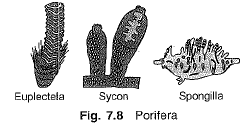 (b) Phylum Coelenterata
(b) Phylum Coelenterata
(i) Coelenterata is a phylum of diploblastic, acoelomate animals having tissue-like organisation, gastrovascular cavity and cnidoblasts.
(ii) All are aquatic and are mostly marine, except a few like Hydra which are found in freshwater. Some of them live in colonies e.g., Obelia.
(iii) They are radially symmetrical (their body can be divided into two halves by any vertical plane passing through the centre). Body cavity (coelenteron) has only one opening called mouth.
(iv) Coelenterates are diploblastic i.e., have only two germ layers. The outer is ectoderm and the inner is the endoderm. The two layers are separated by a non-cellular mesoglea. The body wall encloses a central cavity called coelenteron.
(v) They have only one opening in the body which is used both for feeding and the elimination of food particles and waste materials.
(vi) Coelenterates are unique in having slender, finger-like projections called tentacles. Tentacles have stinging cells or cnidoblasts or nematocysts.
(v) Examples: Hydra, Jellyfish and Sea anemones.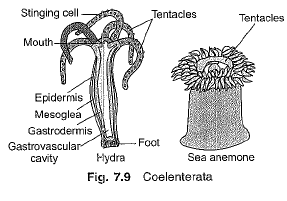 (c) Phylum Platyhelminthes
(c) Phylum Platyhelminthes
(i) A phylum of flatworms where the body is dorsoventrally flattened, triploblastic but acoelomate with organ level of organisation and bilateral symmetry.
(ii) They possess soft, elongated leaf like or tape-like body which exhibits bilateral symmetry.
(iii) Platyhelminthes are mostly parasitic, some are free living (Planaria).
(iv) Respiratory and circulatory systems are underdeveloped.
(v) The nervous system is well developed. The primitive brain is also formed.
(vi) They are bisexual or hermaphrodites.
(viii) Examples: Planaria, Tapeworm (Taenia), Liver fluke (Fasciola).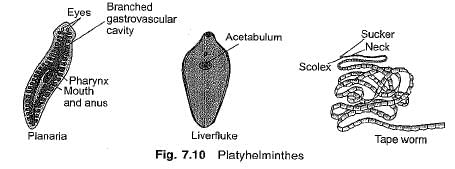 (d) Phylum Nematoda or Nemathelminthes
(d) Phylum Nematoda or Nemathelminthes
(i) Nematoda is a phylum of triploblastic, bilaterally symmetrical but cylindrical worms having pseudocoelom, primitive organ system level of organisation and an elastic cuticle on the outside.
(ii) Some round worms are free-living in soil or water. Most of the others are parasitic (filarial worm).
(iii) Parasitic roundworm like filarial worms cause a disease known as elephantiasis in which the leg of the patient becomes swollen (just like leg of elephant).
(iv) Respiratory and circulatory systems are absent.
(v) Sexes are separate (unisexual) and females produce large number of eggs.
(vi) Examples: Ascaris and Wuchereria (Filarial worm).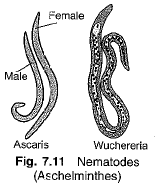 (e) Phylum Annelida
(e) Phylum Annelida
(i) The phylum consists of triploblastic, bilaterally symmetrical, eucoelomate animals having organ system level of organisation and metamerically segmented body.
(ii) The body also shows segmental differentiation of organs.
(iii) Annelida is a large group of animals found in diversified habitats such as moist soil, freshwater as well as seawater. Some forms like leech are parasitic in nature.
(iv) Digestive system is well developed.
(v) Respiration occurs by gills or skin.
(vi) Closed type of circulatory system is present where blood flows only inside the blood vessels.
(vii) It consists of excretory units called nephridia.
(viii) Body bears lateral appendage for locomotion in the form of chitinous setae or parapodia.
(ix) Sexes maybe separate (unisexual) or bisexual (hermaphrodite).
(x) Examples: Earthworm, Nereis and Leech.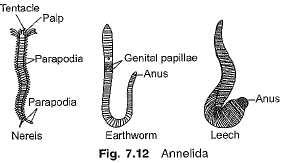 (f) Phylum Arthropoda
(f) Phylum Arthropoda
(i) A phylum of triploblastic, bilaterally symmetrical segmented animals having jointed legs and appendages a chitinous exoskeleton and a blood filled body cavity called haemocoel.
(ii) It is the largest group of animals, which are found in a variety of habitats like land, moist soil, freshwater, marine water and even on the bodies of other animals.
(iii) The body of Arthropods is divisible into head, thorax and abdomen. Head and thorax are fused in some forms to give rise to the cephalothorax.
(iv) Respiration occurs by general body surface, gills or book lungs.
(v) Circulation is of open type i.e., blood does not flow in blood vessels instead remains confined to open space called haemocoel.
(vi) Excretion takes place by malpighian tubules (insects) and green glands (crab and prawn).
(vii) Sexes are separate. The development of animal may involve metamorphosis.
(viii) Phylum Arthropoda has been further subdivided into classes namely Crustacea, Insecta and Arachnida.
(ix) Examples: Insects like housefly, cockroach, butterfly, arachnids like spider, scorpion and crustacea like prawns, lobsters, crab etc.
(g) Phylum Mollusca
Animals of this group are bilaterally symmetrical, triploblastic soft-bodied but shelled with a reduced coelomic cavity, open circulatory system and little segmentation.
(ii) The body is differentiated into head, foot and visceral mass covered by a special fold called mantle. Foot helps in movement.
(iii) It is the second-largest phylum which includes forms which are mostly aquatic. The majority are marine forms, some are found in fresh water and some are even terrestrial.
(iv) Respiration occurs by gills, skin or lungs.
(v) Excretion is brought about by one or two pairs of sac like kidneys.
(vi) In molluscs, eyes and tentacles are present on head. Balancing as well as tasting organs are well developed.
(vii) Sexes are separate larval stage present in its lifecycle.
(viii) Examples: Octopus, Pila, Unio and Chiton.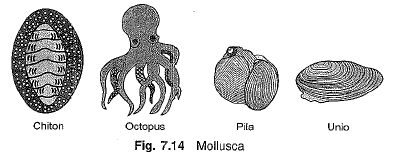 (h) Phylum Echinodermata
(h) Phylum Echinodermata
(i) A phylum of spiny skinned, triploblastic, enterocoelomic marine animals having calcareous skeleton, water-driven tube system and radial symmetry in adults.
(ii) Echinoderms are marine forms which are either free-swimming forms or bottom dwellers while few forms are sessile and attached to the substratum.
(iii) They are unique in having a water vascular system which aids in respiration and locomotion.
(iv) The undersurface bears a number of microscopic appendages called tube feet.
(v) Sexes are usually separate. They have extensive power of regeneration.
(vi) Examples: Feather star (Antedon), Sea cucumber (Holothuria), Sea urchin (Echinus) and Star fish (Asterias).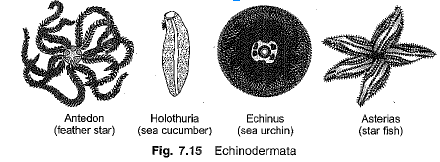 (i) Phylum Protochordata
(i) Phylum Protochordata
(i) Animals are bilaterally symmetrical, triploblastic and coelomate.
(ii) They are non-vertebrate chordates which do not possess brain, cranium, vertebral column, jaws and paired appendages.
(iii) Protochordate are marine animals, exhibits organ system level organisation.
(iv) They possess notochord atleast at some stages of life. It runs along the back of the animal. Dorsal hollow nerve cord, gills slits and post-anal tail are other diagnostic chordate features present in the protochordate.
Examples: Balanoglossus, Herdemania and Amphioxus.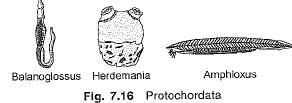 (j) Phylum Vertebrata
(j) Phylum Vertebrata
(i) Animals are bilaterally symmetrical, triploblastic and coelomate.
(ii) It is a subphylum of those chordates in which the notochord has been replaced by an endoskeleton of vertebral column and cranium while the dorsal nerve chord has been transformed into brain and spinal cord.
(iii) Like other chordate vertebrates exhibit complex differentiation of body tissues and organs, possess paired gill pouches and post anal tail during any stage of its lifecycle.
(iv) They have ventral heart.
24. Vertebrates are grouped into following five classes:
(а) Class Pisces
(i) It includes all fishes freshwater as well as marine.
(ii) Fishes have a streamlined body covered with scales or plates.
(iii) Respiration occurs with the help of gills which are able to withdraw oxygen dissolved in water.
(iv) The heart is two-chambered.
(v) Fins and muscular tail aids in locomotion.
(vi) They are cold-blooded.
(vii) Some fishes have cartilaginous skeleton (shark and rays) while some have bony skeleton (rohu, sea horse and flying fish).
(b) Class Amphibia
(i) Amphibia is a class of vertebrate animals with aquatic larval stage and terrestrial adult stage.
(ii) Animals are triploblastic, bilaterally symmetrical and coelomate.
(iii) Skin is smooth and without scales. It has large number of mucus glands which keep the skin moist.
(iv) Respiration is either through gills, lungs or skin.
(v) Heart is three chambered.
(vi) The external ear is absent. Nictitating membrane or third eyelid is present.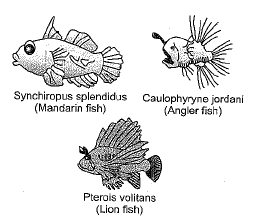
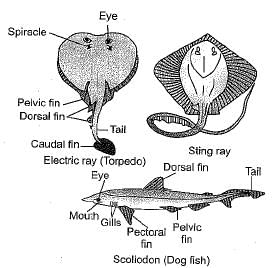

(vii) Amphibians are cold-blooded i.e. cannot maintain constant body temperature.
(viii) Sexes are separate. Fertilisation is external. Amphibians lay soft eggs.
(ix) Examples: Frog (Rana tigrina), Toad (Bufo sp) and Salamander (Salamandra). (c) Class Reptilia
(c) Class Reptilia
(i) Reptilia is a class of vertebrata in which, the animals possess dry skin covered by epidermal scales. Animals are triploblastic, bilaterally symmetrical and coelomate.
(ii) They are creeping and burrowing cold-blooded vertebrates bearing epidermal scales.
(iii) Most of them have a three-chambered heart except in crocodiles where it is four-chambered.
(iv) Reptiles lay hard shelled eggs. Fertilisation is internal.
(v) Development takes place inside the eggs and embryo is protected by extra embryonic membranes.
(vi) Examples: Cobra (Naja naja), Lizard (Hemidactylus), Crocodile (Crocodylus) and Turtle. (d) Class Aves
(d) Class Aves
(i) Aves is a class of warm-blooded vertebrates having forelimbs modified into wings, body covered with feathers and jaws modified into horny toothless beak.
(ii) Birds have streamlined body which is divided into head, neck, trunk and tail. Hind limbs have clawed digits which are adapted for walking, running, perching and digging.
(iii) Animals are triploblastic, bilaterally symmetrical and coelomate.
(iv) Bones are porous and light because of air spaces.
(v) The heart is four-chambered.
(vi) Respiration occurs through the lungs.
(vii) Birds have a keen sense of sight with a poorly developed sense of smell.
(viii) Sexual dimorphism is found in many birds. Fertilisation is internal. Birds are oviparous animals. Eggs contain large amount of yolk and has hard calcareous shell.
(ix) Examples: Ostrich (Struthio camelus), Pigeon (Columba livia), Crow (Crocus splendens), Sparrow (Passer domesticus) (e) Class Mammalia
(e) Class Mammalia
(i) Mammalia is a class of warm-blooded, hairy tetrapod vertebrates having mammary glands in females for feeding the young ones.
(ii) Their skin has hairs as well as sweat and oil glands.
(iii) Animals are triploblastic, bilaterally symmetrical and coelomate.
(iv) They are the most advanced group of animals with a very well developed brain,
(v) Forelimbs and hind limbs have five digits each which end up with claws, hoofs or nails. Limbs are adapted for walking, running, swimming, burrowing and even flying.
(vi) Teeth are of different types and are present in sockets.
(vii) External ear called pinna is present.
(viii) Mammals have a four-chambered heart.
(ix) Sexes are separate and fertilisation is internal. Most mammals give birth to the young ones. Duck-billed platypus and echidna are exceptions and are examples of egg-laying mammals.
(x) Examples : Rat (Rattus rattus), Dog (Canis sp), Tiger (Panthera tigris).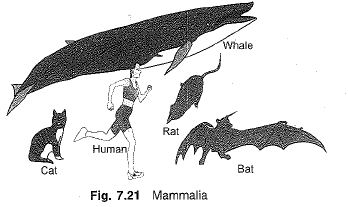
|
153 videos|283 docs|127 tests
|
FAQs on Diversity in Living Organisms Class 9 Notes Science
| 1. What is the importance of diversity in living organisms? |  |
| 2. How do scientists classify living organisms based on their diversity? |  |
| 3. What are the different kingdoms of living organisms? |  |
| 4. How do living organisms adapt to their diverse environments? |  |
| 5. How does diversity in living organisms contribute to human well-being? |  |

















